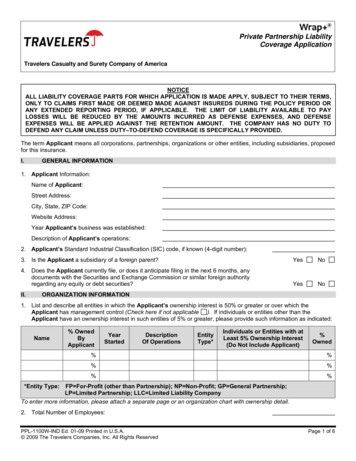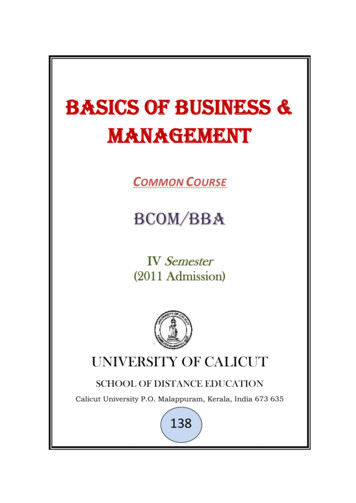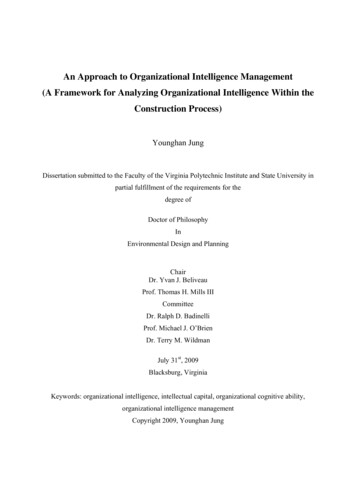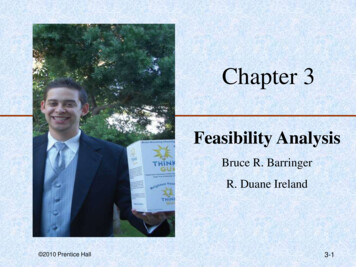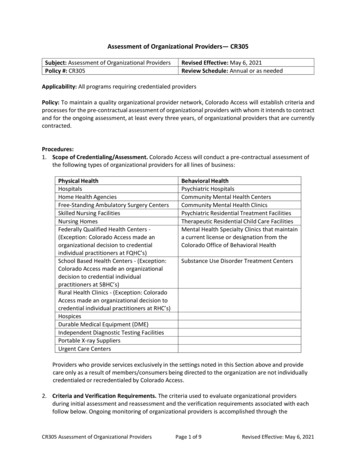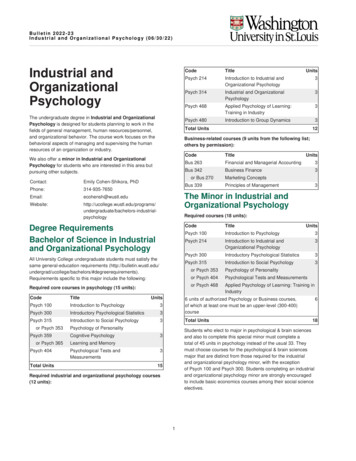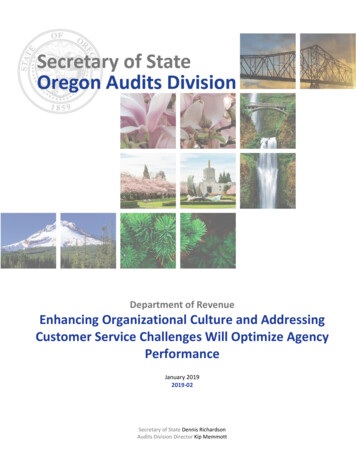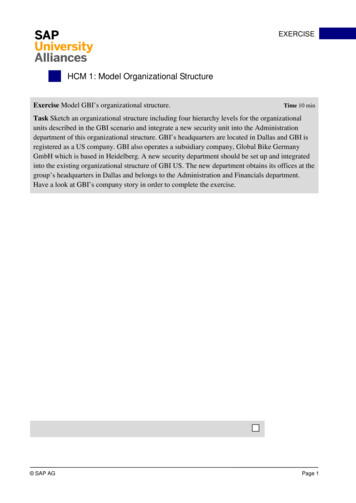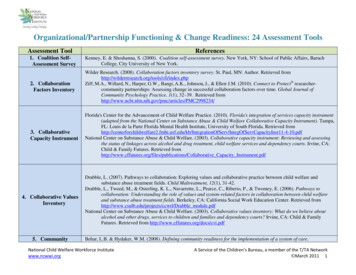
Transcription
Organizational/Partnership Functioning & Change Readiness: 24 Assessment ToolsAssessment ToolReferences1. Coalition SelfAssessment SurveyKenney, E. & Shoshanna, S. (2000). Coalition self-assessment survey. New York, NY: School of Public Affairs, BaruchCollege, City University of New York.2. CollaborationFactors InventoryWilder Research. (2008). Collaboration factors inventory survey. St. Paul, MN: Author. Retrieved iff, M.A., Willard, N., Harper, G.W., Bangi, A.K., Johnson, J., & Ellen, J.M. (2010). Connect to Protect researchercommunity partnerships: Assessing change in successful collaboration factors over time. Global Journal ofCommunity Psychology Practice, 1(1), 32–39. Retrieved 98234/3. CollaborativeCapacity InstrumentFlorida's Center for the Advancement of Child Welfare Practice. (2010). Florida's integration of services capacity instrument(adapted from the National Center on Substance Abuse & Child Welfare Collaborative Capacity Instrument). Tampa,FL: Louis de la Parte Florida Mental Health Institute, University of South Florida. Retrieved dfNational Center on Substance Abuse & Child Welfare. (2003). Collaborative capacity instrument: Reviewing and assessingthe status of linkages across alcohol and drug treatment, child welfare services and dependency courts. Irvine, CA:Child & Family Futures. Retrieved llaborative Capacity Instrument.pdf4. Collaborative ValuesInventory5. CommunityDrabble, L. (2007). Pathways to collaboration: Exploring values and collaborative practice between child welfare andsubstance abuse treatment fields. Child Maltreatment, 12(1), 31-42.Drabble, L., Tweed, M., & Osterling, K. L., Navarrette, L., Pearce, C., Riberio, P., & Twomey, E. (2006). Pathways tocollaboration: Understanding the role of values and system-related factors in collaboration between child welfareand substance abuse treatment fields. Berkeley, CA: California Social Work Education Center. Retrieved fromhttp://www.csulb.edu/projects/ccwrl/Drabble module.pdfNational Center on Substance Abuse & Child Welfare. (2003). Collaborative values inventory: What do we believe aboutalcohol and other drugs, services to children and families and dependency courts? Irvine, CA: Child & FamilyFutures. Retrieved from http://www.cffutures.org/docs/cvi.pdfBehar, L.B. & Hydaker, W.M. (2008). Defining community readiness for the implementation of a system of care.National Child Welfare Workforce Institutewww.ncwwi.orgA Service of the Children’s Bureau, a member of the T/TA Network March 2011 1
Assessment ToolReadinessReferencesWashington, DC: Technical Assistance Partnership for Child and Family Mental Health. Retrieved diness.pdf6. ComprehensiveOrganizationalHealth Assessment(COHA)Butler Institute For Families. (2009). Comprehensive organizational health assessment. Denver, CO: University of Denver.Butler Institute For Families. (2009) Comprehensive organizational health assessment August 2009 baseline: Example COHAresults brief. Denver, CO: University of Denver.7. Diagnosing theHealth of YourCoalition8. Dimensions ofOrganizationalReadiness (DOOR)Kaye, G. (n.d.) Diagnosing the health of your coalition. Lawrence, KS: Community Tool Box, Work Group for CommunityHealth and Development, University of Kansas. Retrieved fromhttp://ctb.ku.edu/en/tablecontents/sub section tools 1058.aspxSchoenwald, S. K., Chapman, J. E., Kelleher, K., Hoagwood, K. E., Landsverk, J., Stevens, J., et al. (2008). A survey of theinfrastructure for children’s mental health services: Implications for the implementation of Empirically SupportedTreatments (ESTs). Administration and Policy in Mental Health and Mental Health Services Research, 35, 84-97.9. Evidence-basedPractice AttitudeScaleAarons, G.A. (2004). Mental health provider attitudes toward adoption of evidence-based practice: The evidence-basedpractice attitude scale (EBPAS). Mental Health Services Research, 6(2), 61-74. Retrieved 64126/Aarons, G.A., Glisson, C., Hoagwood, K., Kelleher, K., Landsverk, J., & Cafri, G. (2010). Psychometric properties and U.S.national norms of the evidence-based practice attitude scale (EBPAS). Psychological Assessment, 22(2), 356-365.Department of Mental Health & Addiction Services. (n.d.). Evidence based practice attitude scale items and scoringinstructions. Hartford, CT: Author. Retrieved from escale.pdf10. GeneralOrganizationalIndex (GOI)North Carolina Evidence Based Practices Center. (2002). Assertive community treatment implementation resource kit: Usinggeneral organizational index for evidence-based practices. Fayetteville, NC: Author. Retrieved h Carolina Evidence Based Practices Center. (2002). General Organizational Index (GOI). Fayetteville, NC: Author.Retrieved from al Child Welfare Workforce Institutewww.ncwwi.orgA Service of the Children’s Bureau, a member of the T/TA Network March 2011 2
Assessment Tool11. Innovation,Diffusion, andAdoption ResearchProject (IDARP)Measures12. Internal CoalitionEffectiveness (ICE)13. Inventory ofProfessionals'Expectations,Norms, Needs, andAspirationsReferencesMassatti, R.R., Sweeney, H.A., Panzano, P.C., & Roth, D. (2007). The de-adoption of innovative mental health practices(IMHP): Why organizations choose not to sustain an IMHP? Administration and Policy in Mental Health and MentalHealth Services Research, 35(1-2), 50-65.Ohio Department of Mental Health. (2011). The Innovation, Diffusion, and Adoption Research Project (IDARP) website.Retrieved option-researchproject.shtmlPanzano, P. & Roth, D. (2006). The decision to adopt evidence-based and other innovative mental health practices: Riskybusiness? Psychiatric Services, 57, 1153-1161.Panzano, P.C., Roth, D., Sweeney, H.A., Massatti, R., Carstens, C., Seffrin, B., & Bunt, E. (2007). The innovation diffusionand adoption research project (IDARP): A process overview and a preview of qualitative data from interviews. In D.Roth & W.J. Lutz (Eds.), New Research in Mental Health, Vol. 17 (pp. 78-89). Columbus, OH: Ohio Department ofMental Health. Retrieved from eview.pdfCramer, M.E., Atwood, J.R., & Stoner, J.A. (2006). Measuring community coalition effectiveness using the ICE instrument.Public Health Nursing, 23(1), 74-87.Lawson, H. (n.d.). Improving the recruitment and retention of human service professionals in public child welfare: Toward aprofessional workforce in workplaces supportive of professionalism. Albany, NY: School of Social Welfare,University at Albany, The State University of New York.14. OrganizationalClimate MeasurePatterson, M.G., West, M.A., Shackleton, V.J., Lawthorn, R., Maitlis, S., Robinson, D.L., & Wallace, A.M. (2005).Validating the organizational climate measure: Links to managerial practices, productivity and innovation. Journal ofOrganizational Behavior, 26(4), 379-408.15. OrganizationalCommitment ScaleBalfour, D. L., & Wechsler, B. (1996). Organizational commitment: Antecedents and outcomes in public organizations.Public Productivity and Management Review, 29, 256-277.National Child Welfare Workforce Institutewww.ncwwi.orgA Service of the Children’s Bureau, a member of the T/TA Network March 2011 3
Assessment ToolReferences16. OrganizationalReadiness forChange (TCU ORC)Courtney, K.O., Joe, G.W., Rowan-Szal, G.A., Simpson, D.D. (2007). Using organizational assessment as a tool for programchange. Journal of Substance Abuse Treatment, 33(2), 131-137.Fuller, B.E., Rieckmann, T., Nunes, E.V., Miller, M., Arfken, C., Edmundson, E., & McCarty, D. (2007). OrganizationalReadiness for Change and opinions toward treatment innovations. Journal of Substance Abuse Treatment, 33(2),183– 192.Greener, J. M., Joe, G. W., Simpson, D. D., Rowan-Szal, G. A., & Lehman, W. E. K. (2007). Influence of organizationalfunctioning on client engagement in treatment. Journal of Substance Abuse Treatment, 33(2), 139-147.Institute of Behavioral Research. (2002). Organizational readiness for change (TCU ORC): Treatment staff version (TCUORC-S) instruction page. Forth Worth, TX: Texas Christian University. Retrieved -s.pdfInstitute of Behavioral Research. (2002). Organizational readiness for change (TCU ORC): Treatment staff version (TCUORC-S) scales and item scoring guide. Forth Worth, TX: Texas Christian University. Retrieved -s-sg.pdfLehman, W.E.K., Greener, J.M., & Simpson, D. (2002). Assessing organizational readiness for change. Journal of SubstanceAbuse Treatment, 22, 197-209.Saldana, L., Chapman, J.E., Henggeler, S.W., Rowland, M.D. (2007). The Organizational Readiness for Change scale inadolescent programs: Criterion validity. Journal of Substance Abuse Treatment, 33(2), 159-169.Simpson, D.D., Lehman, W.E.K., & Flynn, P. M. (n.d.) Overview of evidence: Organizational readiness for change. ForthWorth, TX: Institute of Behavioral Research, Texas Christian University. Retrieved . OrganizationalReadiness to ChangeAssessment (ORCA)Hagedorn, H.J. & Heideman, P.W. (2010). The relationship between baseline Organizational Readiness to ChangeAssessment subscale scores and implementation of hepatitis prevention services in substance use disorders treatmentclinics: A case study. Implementation Science, 5(46).Helfrich, C.D., Li, Y., Sharp, N.D., & Sales, A.E. (2009). Organizational readiness to change assessment (ORCA):Development of an instrument based on the Promoting Action on Research in Health Services (PARIHS) framework.Implementation Science, 4(38).18. OrganizationalSocial ContextGlisson, C. (2002). The organizational context of children’s mental health services. Clinical Child and Family PsychologyReview, 5(4), 233-253.Glisson, C. (2007). Applying the socio-technical and culture models of organization to a science of implementationeffectiveness. Presented at the 2007 annual meeting for the Society for Social Work and Research, January 17, 2007National Child Welfare Workforce Institutewww.ncwwi.orgA Service of the Children’s Bureau, a member of the T/TA Network March 2011 4
Assessment ToolReferences(San Francisco, CA).19. Partnership SelfAssessment Tool20. PurposefulPartnerships in theCommunity Interest21. Readiness forOrganizationalChange22. State HealthAuthority Yardstick(SHAY)23. Spector JobSatisfaction Survey24. Western RegionalRecruitment &Retention ProjectChild WelfareSurveyCenter for the Advancement of Collaborative Strategies in Health. (2006). Partnership self-assessment tool: Questionnaire.New York, NY: New York Academy of Medicine. Retrieved from http://cacsh.org/pdf/psatquestionnaire.pdfMorton, L.W. (2000). Purposeful partnerships in the community interest. Ames, IA: Iowa State University, UniversityExtension. Retrieved from x?ProductID 5417Holt, D.T., Armenakis, A.A., Feilf, H.S., & Harris, S.G. (2007). Readiness for organizational change: The systematicdevelopment of a scale. Journal of Applied Behavioral Science, 43, 232-255.Finnerty, M.T., Rapp, C.A., Bond, G.R., Lynde, D.W., Ganju, V. & Goldman, H (2009). The state health authority yardstick(SHAY). Community Mental Health Journal, 45(3), 228-236.Office of Mental Health Research & Training. (n.d.). Supervision, policy & administration: The state (mental) healthauthority yardstick (SHAY). Retrieved from ervision/index.shtmlSpector, P. (1994). Job satisfaction survey. Tampa, FL: Department of Psychology, University of South Florida. Retrievedfrom http://shell.cas.usf.edu/ pspector/scales/jsspag.htmlButler Institute for Families. (2008). Western Regional Recruitment & Retention Project child welfare survey. Denver, CO:AuthorOther Relevant ResourcesAarons, G. (2007). Measuring organizational readiness. Presented at the National Institutes of Health Conference on Building the Science of Disseminationand Implementation in the Service of Public Health, September 10, 2007 (Bethesda, MD).Aarons, G.A., Hurlburt, M., McCue Horwitz, S. (2011). Advancing a conceptual model of evidence-based practice implementation in public service sectors.National Child Welfare Workforce Institutewww.ncwwi.orgA Service of the Children’s Bureau, a member of the T/TA Network March 2011 5
Other Relevant ResourcesAdministration & Policy in Mental Health & Mental Health Services, 38(1), 4-23.Kimberly, J., & Cook, J. M. (2008). Organizational measurement and the implementation of innovations in mental health services. Administration & Policy inMental Health & Mental Health Services, 35, 11–20.National Child Welfare Workforce Institute. (2010). Implementing change in child welfare: A resource list. Albany, NY: Author. Retrieved e%20in%20CW%20Resources%202010.pdfRivard, J.C. (2005). Measures of organizational readiness. Alexandria, VA: National Association of State Mental Health Program Directions ResearchInstitute, Inc. Retrieved from http://www-dev.rags.kent.edu/CIP web/files/Measures of Organizational Readiness 1382609.pdfWeiner, B., Amick, H., & Lee, S.D. (2008). Conceptualization and measurement of organizational readiness for change: A review of the literature in healthservices research and other fields. Medical Care Research & Review, 65(4), 379-436.Weiner, B. (2009). A theory of organizational readiness for change. Implementation Science, 4.National Child Welfare Workforce Institutewww.ncwwi.orgA Service of the Children’s Bureau, a member of the T/TA Network March 2011 6
Administration & Policy in Mental Health & Mental Health Services, 38(1), 4-23. Kimberly, J., & Cook, J. M. (2008). Organizational measurement and the implementation of innovations in mental health services. Administration & Policy in Mental Health & Mental Health Services, 35, 11-20. National Child Welfare Workforce Institute. (2010).
